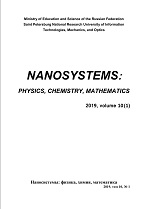|
This article is cited in 3 scientific papers (total in 3 papers)
First observations of entropy vs free energy for lattice based Ising model for spin coarsening in conserved and non-conserved binary mixtures: a phenomenological study of phase transitions in 2D thin films
Satya Pal Singh
Department of Applied Sciences, Madan Mohan Malaviya University of Technology, Gorakhpur, 273010, India
Abstract:
This paper presents the results of Monte Carlo (MC) simulation for paramagnetic, ferromagnetic and antiferromagnetic transitions in 2D thin films. The spin coarsening which lowers energy brings order at the cost of lowering entropy in the presence of an external magnetic field, which in turn, may increase the free energy at relatively higher temperatures because of spin mixing. There is a competition between energy of the system and entropy in conserved and non-conserved binary mixtures in the presence of an external magnetic field. The simulation is done on a lattice of size 100$\times$100 using Metropolis algorithm with periodic boundary conditions. All data are sampled for 20 K MC cycles after a regular interval of 100 MC cycles. The paramagnetic case with spin coupling coefficient and the ferromagnetic and anti-ferromagnetic cases with |$\varepsilon$(AB)| = 0.0 $J_0$, 0.25 $J_0$, 0.50 $J_0$, 0.75 $J_0$ & 1.0 $J_0$ (keeping |$\varepsilon$(AA)| = |$\varepsilon$(BB)| = 1.0 $J_0$) (Here $J_0$ = 1.0 unit of energy) are studied at temperatures $kT$ = 0.25 $J_0$, 0.50 $J_0$, 0.75 $J_0$, 1.0 $J_0$, 1.25 $J_0$, 1.5 $J_0$, 1.75 $J_0$, & 2.0 $J_0$ in presence of varying external magnetic field strengths in order to observe the organizational behavior of spins and the interplay between the free energy and entropy. The induced magnetization and the magnetic susceptibilities are found to be in qualitative agreement with the theory. The paramagnetic to ferromagnetic transition has been observed and explored at high $T$ values. The spin correlation function plotted helps to reveal the spin transport properties of the systems. The spontaneous ferromagnetic transition temperatures for $\varepsilon$(AB) = 1.0 $J_0$, 0.75 $J_0$ & 0.50 $J_0$ are observed as $k_{B}T$ = 0.44 $J_0$, 0.39 $J_0$ & 0.33 $J_0$ (i.e. nearly 96 % magnetizations are observed at these temperatures) respectively at $B$ = 0.0 $J_0$/$\mu$= (i.e. absence of any external magnetic field). This is in quantitative agreement with theory. The spin correlation function diverges at these transition temperatures, which can be understood as the theoretical evidence supporting the observation of spontaneous magnetization. The ferromagnetic to paramagnetic transitions are not very sharp but the range of the spin-spin interaction can be said to decay gradually. Even at higher temperature as $kT$ = 2.0 $J_0$, the opposite spin pair correlation function supports formation of tiny domains with spin transport from one domain to another, whereas for lower temperatures below $kT$ = 1.0 $J_0$, the presence of majority $+1/2$ spins diminish the effect. Tiny domain walls have lower energy surrounded by opposite spins and seem to be energetically preferred. This quasi nature of spin-spin interaction with temperature is also supported by the corresponding ensemble entropy averages.
Keywords:
Ising model, spontaneous magnetization, thin films, spin conservation, super para-magnetism.
Received: 11.09.2015
Revised: 24.10.2015
Citation:
Satya Pal Singh, “First observations of entropy vs free energy for lattice based Ising model for spin coarsening in conserved and non-conserved binary mixtures: a phenomenological study of phase transitions in 2D thin films”, Nanosystems: Physics, Chemistry, Mathematics, 6:6 (2015), 882–895
Linking options:
https://www.mathnet.ru/eng/nano1005 https://www.mathnet.ru/eng/nano/v6/i6/p882
|

|




 Contact us:
Contact us: Terms of Use
Terms of Use
 Registration to the website
Registration to the website Logotypes
Logotypes







 Citation in format
Citation in format 
